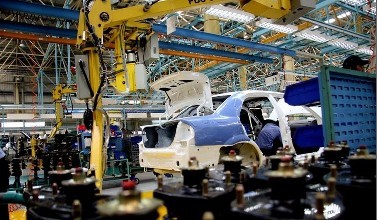- 模板介绍
- 下载记录
- 用户评价
本期参考译文附下期栏目;
上期《水电站土石方工程施工技术要求》参考译文:
1. Preface
xxxx hydroelectric power station located at midstream of Kelani river (at4kmdownstream to interchange of Maskeliya oya tributary and Kehelgamu oya tributary) and with a distance of65kmtoColombo, is a hydroelectric power station privileged to electric power generation. The total storage of the reservoir is216,000 m3, the installed capacity of power station is 35MW, and the average annual energy generation is 126.8GWh. This project is grade four minor (1) works, the grade of main structures is class 4, and the grade of secondary structures is class 5.
This project is moderate head diversion-type hydropower station, which is consisted of main dam, Kehelgamu Oya weir, water intake tunnel of power generation, water transfer tunnel and powerhouse and others.
——Main dam
Main dam is located at downstream of Maskeliya river, about180mto tailrace outlet downstream of Polpitiya powerhouse, and it is concrete gravity dam. The river valley at main dam section is in “U” shape, and the terrain of two banks is asymmetry, with slope angle of right bank 25°-75° and slope angle of left bank 22°-48°. The bedrocks at both sides of river bed are exposed, and colluvial fragments stone layer of 1.0-1.5mthickness is distributed at river bed. The bedrocks are biotite gneiss, granitic gneiss and marble, and the quaternary loose accumulation layer is residual slop accumulation, colluvial accumulation and landslip accumulation.
——Kehelgamu Oya Weir
Kehelgamu Oya Weir is located at downstream of Kehelgamu river, about750mto confluent of Maskeliya river, and it is concrete rolling dam. The terrain of mountain slope of both side of Kehelgamu Oya Weir is steep, with slope angle of right bank 45°-59° and slope angle of left bank 46°-58°. The bedrocks of slope are exposed, and colluvial fragments stone layer of1.0mthickness is distributed at river bed. The bedrocks are gray to dark grey biotite gneiss with granitic gneiss and quartzite.
——Water intake tunnel of power generation
Water intake tunnel of power generation is arranged at left bank of main dam with total length3385mof main tunnel. Water intake tunnel of power generation is low mountain landscape, and tunnel is deeply buried at 10-300m. The gullies along it are “V” shaped valley, terrace is not developed, the slope angle of bank slope is 25-45°, and slope vegetation is rich. The exposure strata of water intake tunnel of power generation from upstream to downstream are in turn grey to greyish-green granitic gneiss with biotite gneiss, grey to off-white marble and grey to dark grey biotite gneiss with quartzite.
The tunnel passes through regional fault F1 of large scale, the width of crush zone is 60-90m, and the width of effecting zone is 10-30m. Furthermore, there are F2, F8 and F11 faults, and the width of fault fracture zone is 8-12m. Scale of other faults is small with width of crush zone 1-2m. The main structural plane has two groups of cracks which are short in extension and closed without filling.
The main karst type of marble section is karst cave, and karst pipeline system with large scale is not found.
——Water transfer tunnel
Terrain along water transfer tunnel is gentle with rich vegetation, the elevation of ground is mostly between 130-189mwith low mountain landscape, and part of tunnel is buried deeper than45mwith maximum of64m.
The exposure strata of water transfer tunnel from upstream to downstream are in turn grey to dark grey biotite gneiss with granitic gneiss, grey to greyish-green granitic gneiss, and the quaternary loose accumulation layer is mainly distributed slope surface along it.
The trend of tunnel is oblique crossing to stratum trend with small angle, and the geologic structure is simple. Large scale fault F2 passes through near the exit with width of crush zone of 30-35m, and furthermore, two minor faults are there.
——Powerhouse
The powerhouse is arranged at left bank of Kelani river, with a distance about4kmto interchange of Kehelgamu oya and Maskeliya oya river, and the installed capacity is 2×17.5MW. The elevation of powerhouse ground is 65-75m, and surface slope is 16-19°. The thickness of upper cover of powerhouse is 5.5-6.0m, which is the quaternary residual slope accumulation with gravel silty clay, and composition of gravel mother rock is biotite gneiss with grain size 1-6cmin edge shape and with intense weathering. The underlying bedrock is grey to dark grey biotite gneiss with quartzite, and the stratum is steep.
The detailed geological conditions of all structures in this project are seen in geological survey report.
2. General Principles
2.1 Earthwork construction of main works of this project shall abide by the regulations of the technical requirements.
2.2 The construction unit must conduct construction surveying of excavation and filling according to regulations of Specification of Construction Survey in Hydroelectric and Hydraulic Engineering (DL/T5173-2003).
2.3 The construction unit must construct according to approved design documents and construction details. The construction unit shall actively adopt and popularize new technology, new materials, new process and new equipments according to features of this project to improve mechanization construction to speed construction progress.
2.4 During construction, the construction unit shall assist geologists to complete the job of geological record and surveying, and when the actual situations do not conform to design conditions, it shall be reported to supervising engineer.
2.5 The construction unit shall do well construction records and collecting and compiling jobs related to data and report.
2.6 The construction unit shall formulate technical safety measures and make safety education to construction workers by implementing policies of safety production and prevention first and according to related national regulations. During construction, carefully conduct safe operation rules, strictly obey labor protection law and hygienic standard and improve working conditions to make civilized construction and to prevent injury and death accident and occupational disease.
2.7 The construction unit shall strengthen quality management, do well quality inspection and intermediate inspection work and ensure project quality.
2.8 The unsettled matters in the technical requirements shall strictly comply with following standards, rules and specifications.
(1) Construction Specifications on Underground Excavating Engineering of Hydraulic Structures (SL 378-2007),
(2) Construction Technical Specification on Rock Foundation Excavation Engineering of Hydraulic Structures (DL/T 5389-2007);
(3) Safety Regulations for Blasting (GB6722-2003);
(4) Specifications for Bolt-shotcrete Support (GB50086-2001);
(5) Specifications for Hydraulic Concrete Construction (DL/T 5144-2001);
(6) Construction Specifications for Formwork of Hydropower & Water Conservancy Engineering (DL/T 5110-2000);
(7) Technical Specification for Cement Grouting Construction of Hydraulic Structures (DL/T 5148-2012);
(8) Specifications of Excavation Blasting for Hydropower and Water Conservancy Project (DL/T 5135-2001);
(9) Technical Specification of Shotcrete and Rock Bolt for Water Resources and Hydropower Project (SL377-2007);
(10) Code for Blasting Safety Monitoring of Hydropower and Water Resources Engineering (DL/T 5333-2005);
(11) Specification of Construction Survey in Hydroelectric and Hydraulic Engineering (DL/T5173-2003);
(12) Inspection and Assessment Specification for Constructional Quality of Hydraulic and Hydroelectric Engineering (SL 176-2007);
(13) Acceptance Code of Practice on Water Resources and Hydroelectric Engineering (SL 223-2008);
(14) Specification for Rolled Earth-rockfill Dam Construction (DL/T5129-2001)
3. Construction Survey
3.1 The construction unit shall make construction survey before the commencement and during construction, and the basic tasks of construction surveying are:
(1) Taking responsibility of holing through survey of tunnel;
(2) Establishing horizontal and elevation control network on ground and underground;
(3) Setting out to the axis, point location, elevation and excavated section of structures;
(4) Surveying vertical and horizontal sections and calculating quantities;
(5) Checking and acceptance of construction parts and drawing as-built drawing and presenting intermediate acceptance and completion acceptance data.
3.2 The holing through survey shall be made before commencement, and the allowable error shall comply with the following regulations:
(1) Limit error of holing through survey: lateral ±10cm; longitudinal ±20cm; vertical ±5cm;
(2) When holing through error is calculated, it’s able to take half of above limit error as allowable mean square error of holing through surface, and to distribute referred to Table 3.2-1;








